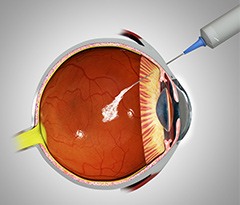Overview

Injections into the eye or surrounding tissues can be made for various reasons. Injections can be made into the vitreous of the eye (intravitreal), behind the eye (retrobulbar), below the conjunctiva (subconjunctival) or under tenon’s capsule (subtenons).
There are two types of Anti-VEGF Injections used here at Imperial Healthcare:
Avastin is an antibody to vascular endothelial growth factor (VEGF), a protein responsible for angiogenesis (new blood vessel growth). Because of Avastin’s ability to bind to VEGF, the VEGF molecule is then unable to bind to its receptor which would lead to angiogenesis. Avastin is approved as an anti-tumor medication for use in specific cancer types. Although Avastin is not approved by the FDA for ocular use, it has proved to be highly efficacious for use in cases of retinal or choroidal neovascularization and macular edema. For ocular use, Avastin is administered via intravitreal injection into the central vitreous through the pars plana in a volume of 0.1mL. The drug can then travel to the back of the eye and through the retina where it binds excess VEGF and inhibits new blood vessel growth for as long as the drug is available.
Lucentis is a modified version of Avastin that has been optimized for ocular use. Like Avastin, Lucentis binds VEGF which stops VEGF from binding to its receptor and promoting angiognesis. Unlike Avastin which is a large antibody, Lucentis is an antibody fragment and is therefore much smaller and better able to penetrate the retina. Lucentis has specifically been designed for use in the eye to treat neovascular (wet) macular degeneration and is approved for this use by the FDA. Lucentis is administered by intravitreal injection into the middle of the vitreous through the pars plana in a volume of 0.05mL. The drug can then travel to the back of the eye and through the retina where it binds excess VEGF and inhibits new blood vessel growth for as long as the drug is available.
Triamcinolone Acetonide
Corticosteroids are hormones that are produced naturally by the body. Triamcinolone acetonide is a synthetic corticosteroid. This class of compounds contains the most potent anti-inflammatory drugs available to us. They work by inhibiting certain reactions in cells which relate to the immune system and allergic responses that produce inflammation. Triamcinolone acetinde is a potent and fairly long lasting version of a corticosteroid. Because of it’s low water solubility, it remains in the eye for long periods of time, only releasing enough compound to be efficacious. Unfortunately, prolonged exposure to corticosteroids can cause high intraocular pressure and induce cataract formation. Triamcinolone is administered intravitreally and in subtenons injections.
For Appointments
Please feel welcome to contact our friendly reception staff with any general or medical enquiry call us.
Opening Hours
Sunday* 10.30 AM – 3.30 PM
Meet Our Doctors
Our medical and support staff hold expertise in their respective fields and are will assist your medical needs with care and compassion




